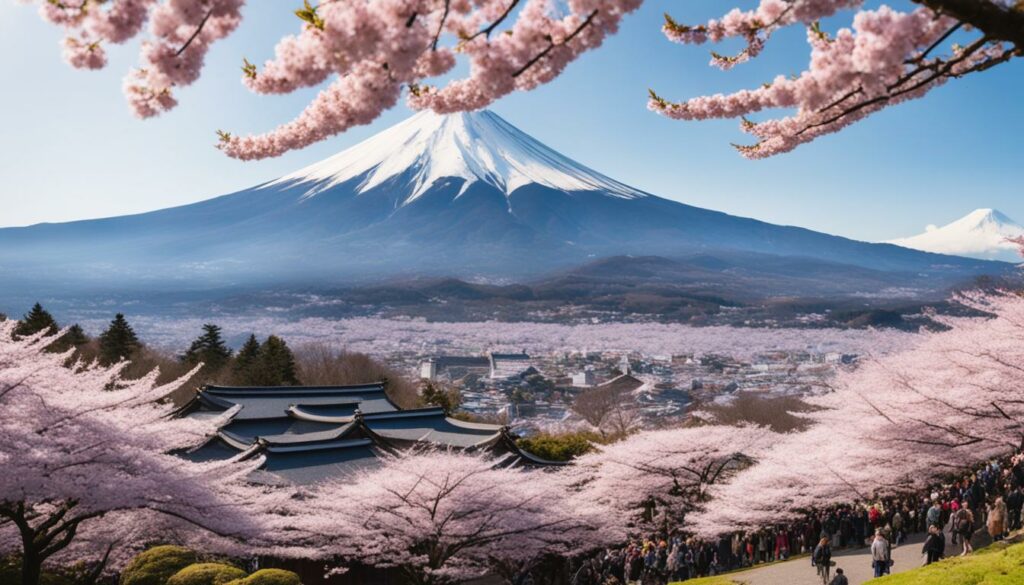Welcome to our exploration of the fascinating facts about Mount Fuji, the renowned peak in Japan. Known for its majestic presence and cultural significance, Mount Fuji attracts climbers and nature enthusiasts from around the world. In this section, we will delve into its height, location, weather conditions, historic eruptions, hiking trails, and cultural importance. Prepare to be amazed by the wonders of this iconic mountain!
Key Takeaways:
- Mount Fuji is a renowned peak in Japan with cultural significance.
- It stands at approximately 3,776 meters (12,389 feet) above sea level.
- The mountain is easily accessible from Tokyo and the surrounding areas.
- The weather conditions on Mount Fuji vary depending on the seasons.
- Mount Fuji has a rich history of significant eruptions.
Mount Fuji’s Height
One of the most awe-inspiring aspects of Mount Fuji is its incredible height. Standing at approximately 3,776 meters (12,389 feet) above sea level, this majestic peak dominates the landscape and captures the imagination of all who behold it.
The towering height of Mount Fuji contributes to its commanding presence and allure. As climbers make their way to the summit, they face the physical and mental challenges that come with ascending to such great heights. The thinning air and steep slopes test their endurance and push them to their limits.
Mount Fuji’s Location
Discover the mesmerizing location of Mount Fuji in Japan, as we uncover its proximity to Tokyo and the surrounding areas. Situated in the Chubu region of Honshu Island, Mount Fuji is conveniently accessible for both locals and tourists.
Located approximately 100 kilometers (62 miles) southwest of Tokyo, Mount Fuji stands as an iconic natural landmark in close reach of the bustling city. Its strategic position makes it a popular day trip destination for visitors seeking a glimpse of Japan’s breathtaking beauty.
“The journey from Tokyo to Mount Fuji is an enchanting experience, with picturesque landscapes along the way,” says renowned travel blogger, Yukiko Tanaka.
The majestic peak of Mount Fuji can be viewed from various vantage points in Tokyo, providing a stunning backdrop to the city’s urban skyline. Its prominent presence has captivated artists, writers, and photographers, inspiring countless artistic creations throughout history.
Due to its close proximity to Tokyo, many tourists choose to incorporate a visit to Mount Fuji into their itineraries when exploring the vibrant capital city. Whether it’s a day trip to the base of the mountain or an adventurous hike to its summit, Mount Fuji offers a captivating experience that blends natural beauty with cultural significance.
Mount Fuji’s Location Details
| Location | Proximity | Distance from Tokyo |
|---|---|---|
| Chubu region, Honshu Island, Japan | Southwest of Tokyo | Approximately 100km (62 miles) |
Mount Fuji’s Weather
When planning your climb up Mount Fuji, it is essential to have a deep understanding of the unique weather patterns that you may encounter along the way. The weather conditions on Mount Fuji can fluctuate dramatically, presenting climbers with various challenges throughout their ascent. The experience can range from scorching heat to freezing cold, depending on the season and elevation.
Seasonal Impact
The different seasons on Mount Fuji bring distinct weather conditions that significantly impact climbing conditions. Let’s take a closer look at the weather patterns you can expect during each season:
- Spring: Spring on Mount Fuji is characterized by cool temperatures, ranging from 5°C to 15°C (41°F to 59°F) at the summit. However, lower altitudes may experience temporary snowfall, making crampons or other traction devices necessary for parts of the trail.
- Summer: Summer brings warmer temperatures, with the summit averaging around 10°C to 15°C (50°F to 59°F). However, even though it is the warmest season, unpredictable weather can still occur. It is crucial to be prepared for sudden rainstorms, strong winds, and temperature drops.
- Fall: Autumn weather on Mount Fuji is generally milder, with temperatures ranging from 5°C to 10°C (41°F to 50°F) at the summit. The foliage transforms into beautiful hues of red, orange, and yellow, creating breathtaking scenic views along the hiking trails.
- Winter: Winter on Mount Fuji is harsh, with bitterly cold temperatures dropping to -10°C to -5°C (14°F to 23°F) at the summit. Heavy snowfall and strong winds make climbing extremely challenging and dangerous. It is advised to attempt a winter climb only if you have previous mountaineering experience and proper equipment.
Precautions and Safety
Climbing Mount Fuji requires careful planning and preparation, especially concerning the unpredictable weather. Here are some essential precautions to ensure your safety:
- Dress in Layers: Layering your clothing will allow you to adjust to the changing temperatures throughout your climb. Wear moisture-wicking and breathable fabrics to stay comfortable.
- Check Weather Forecasts: Before embarking on your journey, monitor weather forecasts from reliable sources. Avoid climbing during inclement weather or when storms are predicted.
- Stay Hydrated: Dehydration can occur even in cold weather, so it’s vital to drink plenty of fluids and carry an adequate water supply.
- Use Sun Protection: Regardless of the season, UV rays at higher altitudes can be intense. Wear sunscreen, sunglasses, and a hat to protect your skin and eyes.
- Watch for Warning Signs: Pay attention to any signs of altitude sickness, hypothermia, or heat exhaustion. If you experience symptoms such as dizziness, nausea, or extreme fatigue, descend immediately and seek medical help if necessary.
Navigating the ever-changing weather conditions on Mount Fuji requires a combination of preparation, flexibility, and respect for the mountain. With proper precautions and an understanding of the weather’s influence, you can embark on a safe and unforgettable adventure.
| Season | Temperature Range at the Summit | Main Weather Conditions |
|---|---|---|
| Spring | 5°C to 15°C (41°F to 59°F) | Temporary snowfall, cool temperatures |
| Summer | 10°C to 15°C (50°F to 59°F) | Sudden rainstorms, strong winds |
| Fall | 5°C to 10°C (41°F to 50°F) | Milder temperatures, beautiful foliage |
| Winter | -10°C to -5°C (14°F to 23°F) | Heavy snowfall, strong winds, extreme cold |
Mount Fuji’s Eruption History
Mount Fuji, an iconic volcano in Japan, has a rich history of volcanic eruptions, leaving a lasting impact on the surrounding landscapes and local communities. These eruptions have played a significant role in shaping the geological, cultural, and historical aspects of the region.
“Volcanic eruptions are powerful events that can reshape the land and alter the lives of those living nearby. Mount Fuji’s eruptions are no exception, leaving behind a legacy of destruction and transformation.”
Throughout its history, Mount Fuji has experienced several notable eruptions, the most recent of which occurred in 1707. This eruption, known as the Hoei Eruption, lasted for over two weeks and had a profound effect on the surrounding areas, causing widespread ash and debris to cover nearby towns and cities.
The Hoei Eruption was not only significant due to its impact on the landscape but also because it marked a turning point for Japan’s understanding of volcanology. It led to the first scientific study of volcanic activity in the country and set the stage for further research and monitoring of volcanic phenomena.
The Impact of Eruptions
Mount Fuji’s eruptions have left a lasting impact on the surrounding landscapes, creating unique geological formations such as lava flows and ash deposits. These features contribute to the area’s scenic beauty, attracting visitors from around the world.
Additionally, volcanic eruptions have influenced local ecosystems, shaping the flora and fauna of the region. Over time, plants and animals have adapted to the volcanic soil and the unique conditions created by eruptions, creating a diverse and resilient ecosystem.

Volcano Monitoring and Preparedness
The historical eruptions of Mount Fuji have highlighted the importance of volcano monitoring and preparedness measures. Today, the Japan Meteorological Agency closely monitors the volcano’s activity, using modern technology to detect any changes that may indicate an impending eruption.
Through monitoring and research, scientists aim to gain a deeper understanding of Mount Fuji’s volcanic behavior, enabling them to improve eruption forecasting and mitigate the potential risks to nearby communities.
In conclusion, Mount Fuji’s eruption history is a testament to the power and beauty of nature. While eruptions have caused destruction in the past, they have also shaped the landscape, influenced local ecosystems, and contributed to scientific knowledge. Understanding this history is crucial for appreciating the significance of Mount Fuji and its ongoing role in the natural world.
Mount Fuji’s Hiking Trails
Embark on an unforgettable adventure as you explore the diverse hiking trails on Mount Fuji. Whether you’re an experienced hiker or a beginner seeking a thrilling outdoor experience, Mount Fuji offers a range of options to suit every skill level. Get ready to witness breathtaking views and immerse yourself in the natural beauty of this iconic peak.
Here are some of the popular hiking trails on Mount Fuji:
Yoshida Trail
The Yoshida Trail is the most commonly chosen route for climbers, offering a moderate difficulty level. This trail starts from the fifth station and is approximately 6 kilometers (3.7 miles) long. Ascending the Yoshida Trail allows hikers to experience stunning panoramic views of the surrounding landscapes.
Subashiri Trail
If you prefer a less crowded route, the Subashiri Trail is a great choice. With a slightly higher difficulty level, this trail begins at the Subashiri fifth station and covers a distance of around 8 kilometers (5 miles). Hikers on the Subashiri Trail are rewarded with picturesque scenery and a serene atmosphere.
Gotemba Trail
For those seeking a challenging hiking experience, the Gotemba Trail offers a thrilling ascent. This trail starts at the Gotemba fifth station and stretches for approximately 9 kilometers (5.6 miles). While the Gotemba Trail is known for its steepness, it provides hikers with remarkable views of the surrounding landscapes.
No matter which trail you choose, be prepared for changing weather conditions and ensure you have proper hiking gear. Remember to pace yourself, stay hydrated, and take breaks when needed.
Hiking on Mount Fuji is a rewarding experience that allows you to connect with nature and push your limits. As you conquer the trails, you’ll be captivated by the beauty that surrounds you.
So, lace up your hiking boots, grab your backpack, and set out on the memorable journey of conquering Mount Fuji’s hiking trails. You’ll create lasting memories and have incredible stories to share.
| Trail | Difficulty Level | Distance |
|---|---|---|
| Yoshida Trail | Moderate | 6 km (3.7 miles) |
| Subashiri Trail | Moderate | 8 km (5 miles) |
| Gotemba Trail | Challenging | 9 km (5.6 miles) |
Mount Fuji’s Cultural Significance
Japan’s iconic Mount Fuji holds immense cultural significance, deeply ingrained in the country’s history and traditions. Revered for centuries, this majestic peak has captured the imagination of both locals and visitors, transcending its physical presence to become a symbol of Japan’s spiritual and artistic heritage.
Mount Fuji’s spiritual importance is rooted in Shintoism and Buddhism, the predominant religions of Japan. It is believed to be the dwelling place of gods and a sacred site for pilgrims seeking enlightenment and purification. The mountain’s symmetrical beauty and peaceful atmosphere inspire a sense of awe and reverence, making it a popular destination for spiritual retreats and meditation.
Artists and writers have long drawn inspiration from Mount Fuji’s captivating landscapes. Its iconic silhouette has been immortalized in countless paintings, woodblock prints, and literary works, reflecting the mountain’s enduring popularity as a muse. Renowned ukiyo-e artist Katsushika Hokusai’s series ‘Thirty-Six Views of Mount Fuji’ showcases the mountain’s various moods and its integration into everyday life, cementing its status as an artistic masterpiece.
In recognition of its cultural significance, Mount Fuji was designated as a UNESCO World Heritage Site in 2013. This prestigious status acknowledges its outstanding universal value and the need for its protection and preservation for future generations to appreciate and cherish.
In the words of renowned Japanese poet Matsuo Basho, “In the land of morning calm, Mount Fuji stands alone, majestic and eternal.”
Now that we have explored Mount Fuji’s cultural significance, let’s take a closer look at the practical aspects of experiencing this remarkable landmark. In the next section, we will delve into the various hiking trails that allow visitors to ascend this magnificent peak and witness its breathtaking beauty up close.
| Key Cultural Aspects | Cultural Significance |
|---|---|
| Religious Importance | Mount Fuji is considered a sacred site in Shintoism and Buddhism, attracting pilgrims seeking spiritual enlightenment and purification. |
| Inspiration for Artists and Writers | The mountain’s serene beauty has inspired numerous artworks and literary works, serving as a symbol of Japan’s artistic heritage. |
| UNESCO World Heritage Site | Mount Fuji’s cultural value is globally recognized, leading to its designation as a UNESCO World Heritage Site. |
Conclusion
In conclusion, Mount Fuji is more than just a towering peak in Japan. It is a testament to the country’s rich history, cultural significance, and natural beauty. Standing at approximately 3,776 meters above sea level, this iconic mountain draws nature enthusiasts and adventure seekers from around the world.
Whether you choose to embark on one of its challenging hiking trails or simply admire its majestic presence from afar, Mount Fuji offers an unforgettable experience. Its breathtaking landscapes, encompassing lush forests, serene lakes, and picturesque vistas, provide a visual feast for the senses.
Moreover, Mount Fuji holds a deep spiritual importance in Japanese culture. It has inspired countless artists, poets, and writers throughout history, serving as a muse for their creations. Designated as a UNESCO World Heritage Site, this mountain holds a special place in the hearts of locals and visitors alike.
So, whether you are seeking adventure, cultural immersion, or simply a moment of serenity, a visit to Mount Fuji is a must. Experience the awe-inspiring beauty of Japan’s most iconic peak and create memories that will last a lifetime.
FAQ
What is the height of Mount Fuji?
Mount Fuji stands at approximately 3,776 meters (12,389 feet) above sea level.
Where is Mount Fuji located?
Mount Fuji is situated in Japan, specifically in the Chubu region, on Honshu Island. It is about 100 kilometers southwest of Tokyo.
What weather conditions can be expected on Mount Fuji?
Mount Fuji experiences a range of weather conditions due to its elevation and location. Climbers and visitors should be prepared for temperature variations, potential storms, and fluctuating conditions influenced by the seasons.
What is the eruption history of Mount Fuji?
Mount Fuji has a historic record of eruptions, with the most recent eruption occurring in 1707. These volcanic activities have shaped the surrounding landscapes and have cultural significance in Japan.
Are there hiking trails on Mount Fuji?
Yes, Mount Fuji offers various hiking trails for adventurers of all skill levels. These trails vary in difficulty level, duration, and offer breathtaking views of the surrounding landscapes.
What is Mount Fuji’s cultural significance?
Mount Fuji holds immense cultural significance in Japanese history and traditions. It is considered a sacred mountain, a symbol of national identity, and has been an inspiration for countless artists and writers throughout centuries.




